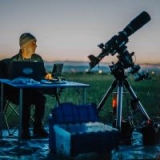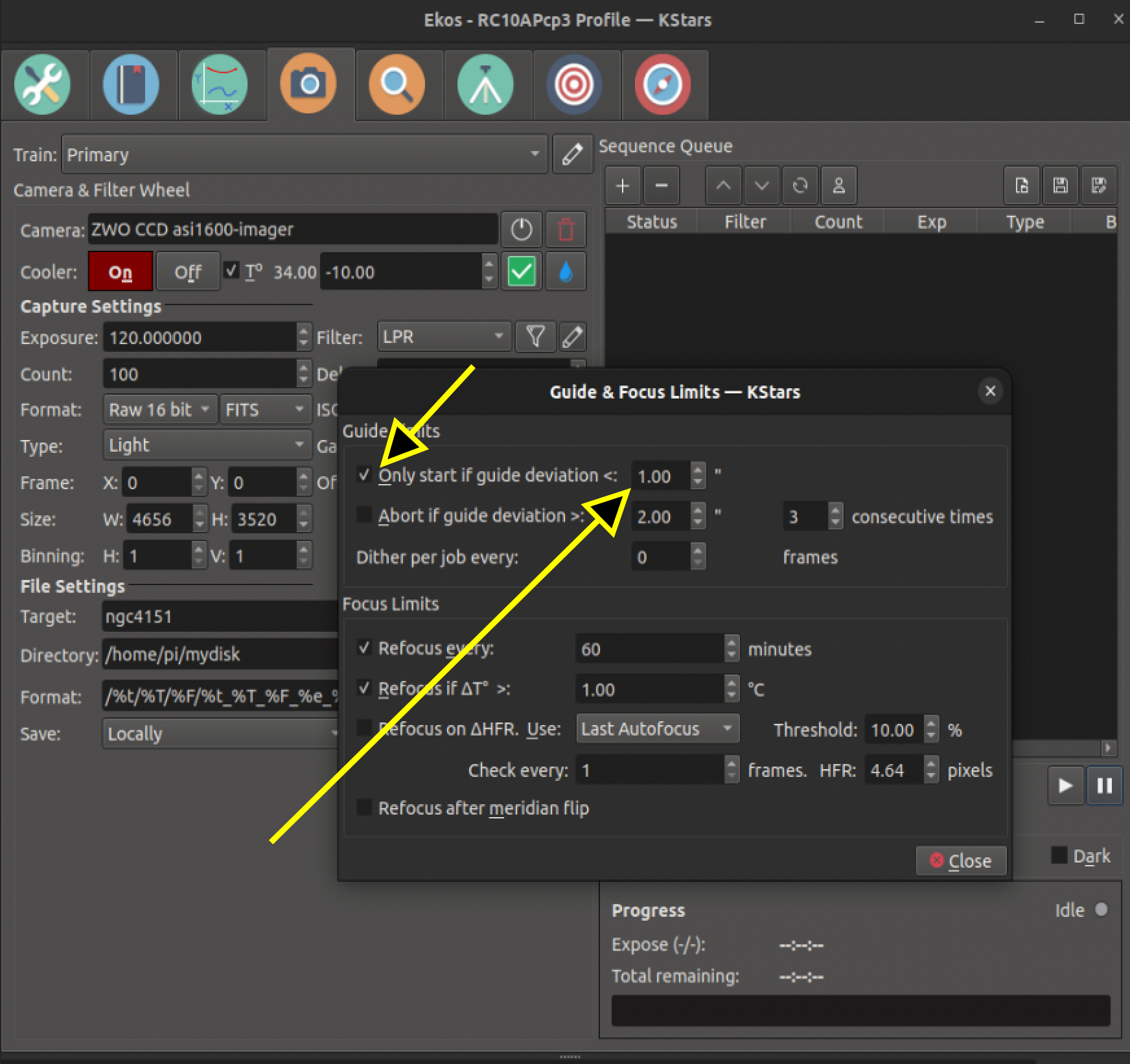Very reasonable numbers! So when the guide star remains within the box after ca. a minute of re-focusing, that's actually very good thus polar alignment is not an issue at all. It should take just 2 or 3 correction pulses to get the guide star centered again. With correction pulses being sent after every guide frame, this should take about 5 seconds. I have no idea why this would take minutes. Even if "max response" had been set to an unreasonably low value it STILL would take just a few seconds. Backlash should have no effect on RA guiding and if you had huge backlash in DEC your RMS would be much worse than what you actually see. It appears to me something else must be going wrong and I'm running out of ideas.
×
INDI Library v2.0.7 is Released (01 Apr 2024)
Bi-monthly release with minor bug fixes and improvements
Focusing/Guiding interference: problem and wish list ;-)
Focusing/Guiding interference: problem and wish list ;-) was created by JuergenN
Hi all,
last night I encountered the following problem:
I set in the scheduler focusing after every 60 minutes. Focusing worked fine, but the guiding star moved some arc seconds during the focusing procedure, but was still in the green square. This leads to the problem, that after restart guiding and subsequent starting of the new image the guider tried to get the guiding star at the "right" position. This leads to elongated stars (and therefore bad pictures) after every focusing run! I'm guiding with OAG, so last night I had a focal length of 1500mm.
Would it be possible to handle guiding after focusing the same as after dithering? After dithering the "delta" of the guiding star is set to zero if I'm correct.
My rig: EQ8-R, 12" F5 Newton, Guiding with OAG, Kstars 3.6.9, INDI 2.0.6. Guide log attached.
Thanks a lot.
Jürgen
last night I encountered the following problem:
I set in the scheduler focusing after every 60 minutes. Focusing worked fine, but the guiding star moved some arc seconds during the focusing procedure, but was still in the green square. This leads to the problem, that after restart guiding and subsequent starting of the new image the guider tried to get the guiding star at the "right" position. This leads to elongated stars (and therefore bad pictures) after every focusing run! I'm guiding with OAG, so last night I had a focal length of 1500mm.
Would it be possible to handle guiding after focusing the same as after dithering? After dithering the "delta" of the guiding star is set to zero if I'm correct.
My rig: EQ8-R, 12" F5 Newton, Guiding with OAG, Kstars 3.6.9, INDI 2.0.6. Guide log attached.
Thanks a lot.
Jürgen
Attachments:
Please Log in or Create an account to join the conversation.
Replied by Alfred on topic Focusing/Guiding interference: problem and wish list ;-)
Attachments:
Please Log in or Create an account to join the conversation.
Replied by JuergenN on topic Focusing/Guiding interference: problem and wish list ;-)
Hi Alfred,
thank you for the comment. I'm aware of that setting. The problem was, that the settling took nearly the whole 300s of the image. I had set the aggresivity of RA and DEC to I think 60 or 70% so it took a while to get the guide stars back to where Kstars thought they should be
thank you for the comment. I'm aware of that setting. The problem was, that the settling took nearly the whole 300s of the image. I had set the aggresivity of RA and DEC to I think 60 or 70% so it took a while to get the guide stars back to where Kstars thought they should be
3 weeks 7 hours ago
#100241
Please Log in or Create an account to join the conversation.
Replied by Alfred on topic Focusing/Guiding interference: problem and wish list ;-)
Hi Jürgen,
are you sure your mount is correctly polar aligned? if I understand you correctly during re-focusing your guide star moves away to such an extent that it takes guiding 5 minutes to get it back to where it was? Even at an aggressiveness of 60% this should be accomplished in a matter of seconds. What is your "max response (arcsec)" setting?
are you sure your mount is correctly polar aligned? if I understand you correctly during re-focusing your guide star moves away to such an extent that it takes guiding 5 minutes to get it back to where it was? Even at an aggressiveness of 60% this should be accomplished in a matter of seconds. What is your "max response (arcsec)" setting?
3 weeks 6 hours ago
#100242
Please Log in or Create an account to join the conversation.
Replied by Alfred on topic Focusing/Guiding interference: problem and wish list ;-)
I see you mentioned your guide star was still within the square after focusing. It definitely should take very few seconds only to get it centered again.
Please Log in or Create an account to join the conversation.
Replied by JuergenN on topic Focusing/Guiding interference: problem and wish list ;-)
Polar alignment was according to PHD2logviewer 3' or 0.3' depending on the pier side, so not that bad. Guiding itself was between 0.5" rms and 0.9", depending on seeing that night.
If I think further about the issue, perhaps 0.3' is too good and/or backlash maybe the problem. If the weather is ok tonight, I will change balancing a bit. And I will have a look on the "max response" value, but it should be on default value.
And you are right, it should be no problem for the mount to get it back.
If I think further about the issue, perhaps 0.3' is too good and/or backlash maybe the problem. If the weather is ok tonight, I will change balancing a bit. And I will have a look on the "max response" value, but it should be on default value.
And you are right, it should be no problem for the mount to get it back.
Please Log in or Create an account to join the conversation.
Replied by Alfred on topic Focusing/Guiding interference: problem and wish list ;-)
Very reasonable numbers! So when the guide star remains within the box after ca. a minute of re-focusing, that's actually very good thus polar alignment is not an issue at all. It should take just 2 or 3 correction pulses to get the guide star centered again. With correction pulses being sent after every guide frame, this should take about 5 seconds. I have no idea why this would take minutes. Even if "max response" had been set to an unreasonably low value it STILL would take just a few seconds. Backlash should have no effect on RA guiding and if you had huge backlash in DEC your RMS would be much worse than what you actually see. It appears to me something else must be going wrong and I'm running out of ideas.
Please Log in or Create an account to join the conversation.
- Hy Murveit
-

- Away
- Administrator
-

- Posts: 1226
- Thank you received: 566
Replied by Hy Murveit on topic Focusing/Guiding interference: problem and wish list ;-)
Juergen,
What I do for that situation is set Capture's guide limit start setting.
This way, capture doesn't start until the guider corrects the drift. In fact your example is the reason that that parameter was implemented.
Note that I believe this parameter is a property of the capture sequence file (as opposed to a global parameter) so I believe that you'd need to load a sequence file, set the parameter, and then save your sequence file, so that the next time you loaded that sequence file the parameter would still be checked.
Hy
What I do for that situation is set Capture's guide limit start setting.
This way, capture doesn't start until the guider corrects the drift. In fact your example is the reason that that parameter was implemented.
Note that I believe this parameter is a property of the capture sequence file (as opposed to a global parameter) so I believe that you'd need to load a sequence file, set the parameter, and then save your sequence file, so that the next time you loaded that sequence file the parameter would still be checked.
Hy
3 weeks 3 hours ago
#100249
Attachments:
Please Log in or Create an account to join the conversation.
Replied by JuergenN on topic Focusing/Guiding interference: problem and wish list ;-)
Alfred, Hy, thank you for your comments. So I will try the next time to adjust balancing and will try the guide limits.
One last question: when calibrating there are movements in RA "in" and "out", also for DEC there is "in" and "out". Can someone tell me, which is north/south or east/west? I'm asking, because I used this in PHD2 to adjust balancing. In my case the DEC "in" movement was a little bit unnormal (thats why I think its a balancing issue). This would help for adjusting weight in the right direction. PHD2 tells you if the movement is south or north...
One last question: when calibrating there are movements in RA "in" and "out", also for DEC there is "in" and "out". Can someone tell me, which is north/south or east/west? I'm asking, because I used this in PHD2 to adjust balancing. In my case the DEC "in" movement was a little bit unnormal (thats why I think its a balancing issue). This would help for adjusting weight in the right direction. PHD2 tells you if the movement is south or north...
3 weeks 3 hours ago
#100250
Please Log in or Create an account to join the conversation.
- Hy Murveit
-

- Away
- Administrator
-

- Posts: 1226
- Thank you received: 566
Replied by Hy Murveit on topic Focusing/Guiding interference: problem and wish list ;-)
I can't answer for PHD2, but for the Ekos internal guider, the stages are (1) increment RA, (2) decrement RA, (3) increment DEC, (4) decrement DEC.
It's probably similar for PHD2, however to be sure you can find out by just letting it calibrate and watching the mount's reported RA and DEC angles (e.g. in the Ekos mount tab).
That is, in the RA stages you should see the DEC stay the same and the RA change consistently in one direction when going out and the other when coming back in.
It's probably similar for PHD2, however to be sure you can find out by just letting it calibrate and watching the mount's reported RA and DEC angles (e.g. in the Ekos mount tab).
That is, in the RA stages you should see the DEC stay the same and the RA change consistently in one direction when going out and the other when coming back in.
The following user(s) said Thank You: JuergenN
3 weeks 2 hours ago
#100252
Please Log in or Create an account to join the conversation.
Replied by JuergenN on topic Focusing/Guiding interference: problem and wish list ;-)
Short update from last night: I put more weight on the mirror side of the Newtonian. After that, the guiding calibration worked far better and the problem with guiding after focusing was also solved 
The following user(s) said Thank You: Alfred
2 weeks 6 days ago
#100261
Please Log in or Create an account to join the conversation.
Time to create page: 0.910 seconds
© 2003-2022 by INDI Library. All rights reserved.



